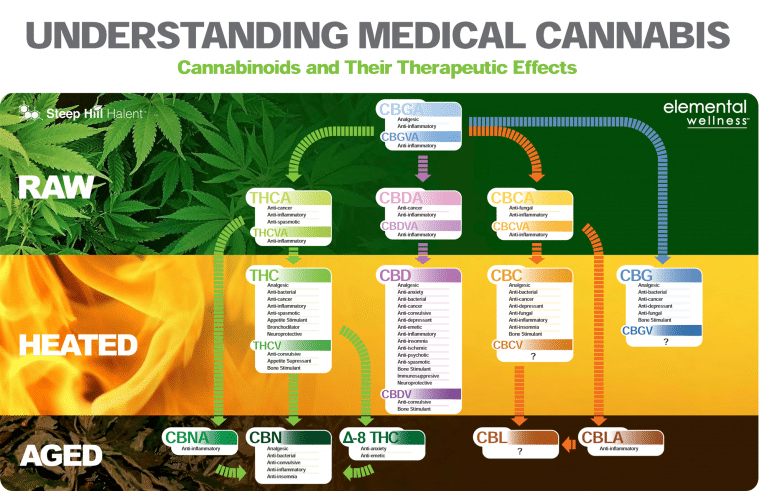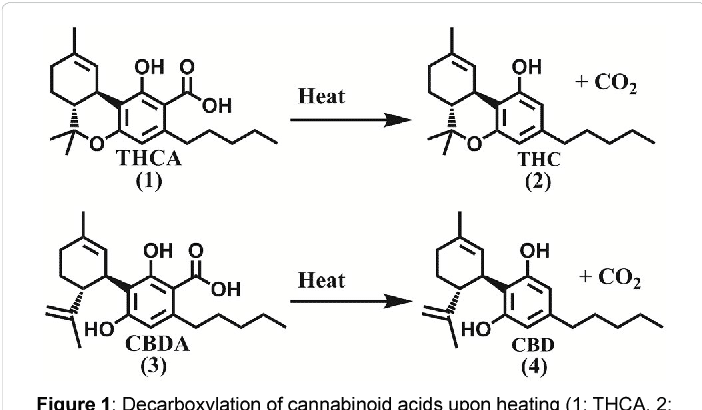If you’ve ever looked at third party lab reports for a CBD product, you’ve probably noticed the myriad of cannabinoids listed. In addition to the popular CBD and THC cannabinoids, things such as CBDa and THCa are also included in the reports.
These cannabinoids are typically found in very small amounts compared to CBD and THC. But you may be wondering what they are. You may also be wondering why someone can consume “raw” cannabis flower and have no intoxicating effects.
In this article, we’ll explain these cannabinoids, CBD decarboxylation, and other information that will answer these questions.
What is CBDa and THCa?
Contrary to popular belief, cannabis plants don’t produce CBD or THC as they grow. Instead, they produce the acid precursors to those cannabinoids, CBDa and THCa.
This is why if you look at the lab tests for “raw” cannabis flower, you’ll notice it being much higher in THCa and CBDa than most other cannabinoids. In fact, before the THCa and CBDa comes the cannabinoid CBGa. Often considered the “mother” cannabinoid, all other cannabinoids stem from CBGa.
The nifty chart below helps demonstrate the growth of cannabinoids and the conversions they can go through.

These acid precursor cannabinoids are not “activated” and the THCa is largely non-intoxicating compared to THC. Despite the fact that they’re considered not “activated”, it would be wrong to assume that means the acid precursor cannabinoids are inactive or useless.
These cannabinoids tend to be lesser studied cannabinoids, and less sought after, but some of the benefits of CBDa are its anti-cancer, anti-inflammatory, and anti-emetic properties.
You may now be wondering how CBDa and THCa convert into CBD and THC. That is done using a process called decarboxylation.
What is Decarboxylation?
The “a” tagged on to the end of CBDa and THCa stands for something called a carboxylic acid group. This group needs to be broken off and removed by decarboxylation to get CBD and THC.

Decarboxylation is when you expose cannabis to heat. Heat and time are the two main factors with CBD decarboxylation. Some of the THCa and CBDa can convert naturally due to the natural sun beating down, curing, and drying.
So it’s not surprising to see minor amounts of the “active” cannabinoids present on lab tests of “raw” cannabis. But to really get that conversion going, more intervention is needed.
For some, this means smoking or vaping the flower itself. Smoking or vaping decarbs the flower immediately which is then inhaled. But smoking or vaping isn’t always the preferred method. Nor does everyone have access to flower.
In fact, smoking is actually pretty inefficient at converting all cannabinoids due to the high heat. Much is degraded and lost, especially terpenes.
Additional processing is required to make popular products such as sublingual drops, edibles and topicals. For these, the raw cannabis material has to be decarboxylated.
This must be done over longer periods of time and at lower temperatures. There are various processes by which this is done. But the end result is often a concentrated, decarboxylated cannabis extract that is then infused into the sublingual drops, edibles, or topicals.
Other Cannabinoid Conversions
While we’re at it, let’s quickly discuss some other interesting conversions, such as CBN and 11-Hydroxy-THC.
CBN, another popular cannabinoid, is actually degraded THC. Through additional decarboxylation (time and heat), the “activated” THC converts into CBN. Often, this decarbing is unintentional.
Flower that has been improperly stored for extended periods of time (sometimes years) and then used tends to be extra sedating. This is due to the growing presence of CBN. This cannabinoid is especially popular for insomnia and sleep due to its extra sedating effects.
Another cannabinoid that’s interesting is 11-Hydroxy-THC. Have you ever wondered why high THC edibles tend to get people extremely “high” and intoxicated with even the smallest amounts? It’s due to 11-Hydroxy-THC. This cannabinoid actually isn’t produced naturally by cannabis either.
When you consume THC via edible forms, it converts within the body into 11-Hydroxy-THC. It’s also incredibly potent and considered even more intoxicating than regular THC. So, be careful with those edibles!
Thankfully, CBD is non-intoxicating. So CBD edibles from hemp do not carry this risk of conversion.
Does CBD Convert to THC in the Body?
The question of whether CBD converts to THC in the body has been a hot topic in the past. Various studies have popped up in articles as “proof” of the ability of CBD to convert to THC. But can it really? Is there enough evidence to back up those claims?
The World Health Organization’s report on CBD states the following on the conversion of CBD to THC: “Overall, there is no evidence that this transformation occurs in humans after oral CBD administration.”
We believe that it is more likely for one to test positive on a drug test when taking “pure” CBD products because of trace amounts of THC still in the CBD isolate. Let’s discuss some key points.
“In Vitro” Versus “In Vivo”
There is a difference between “in vitro” and “in vivo” when it comes to scientific testing and research.
“In vitro” refers to performing an experiment or procedure outside of a living organism in a controlled environment, such as in a test tube or petri dish.
“In vivo” refers to performing the experiment or procedure within a living organism, such as an animal or human.
This distinction is important because it is incredibly common for in vitro studies to not directly translate to in vivo studies when it comes to the results or expected outcomes. Testing something in a test tube is very different from testing something outside of that controlled environment in a real, living creature.
This is not to say that in vitro studies aren’t useful. But as with anything with science, they need to be taken with a grain of salt and not as absolute proof. Additionally, it is also common for the results of animal studies done in vivo to not be able to be replicated when tried in human studies.
Why This Matters
The reason this is important to understand is because the vast majority of studies demonstrating the potential of CBD to convert to THC in the stomach was done in vitro, not in vivo.
Of the very few done in vivo, there was no evidence to support the claims that CBD converted to THC within the body. For example, this March 2020 study concludes that CBD taken orally will not convert into THC in humans.
Other Beliefs
It’s not uncommon for people to test positive on a drug test for THC even when taking CBD products that are marketed as “THC free.” Some point to this as proof that CBD converts to THC in the body.
The reality likely has to more to do with how third party lab equipment is calibrated, and less with the human body. It is very difficult to remove all traces of THC in CBD products made from pure isolate. And while the isolate can be made quite pure (99.9+%), companies still have yet to achieve a truly 100% pure product.
Testing equipment at third party labs have something called a lower detection limit. This means that their equipment can only detect down to a certain amount. So the product may be free of THC over a certain detection limit, but it can still have trace amounts not being detected below the limit. Initial use of these products is unlikely to yield a positive drug test, but prolonged use certainly increases the risk.


One Response
comprehensive information on origins of CBD and THC. I am extremely interested in the other cannabinoids especially the health impacts of CBN, CBG and CBC along with Terpenes and their actions and health benefits. After all in bygone years when womenfolk,monks etc were healers everything came from the earth and was plant based, we forget that Digoxin (a cardiac drug) originated from the Foxglove plant and to this day if consumed is highly toxic…………personally I have been on a quest for CBD with high ratio of CBN and to my dismay only found one company, Thoughtcloud, that carries such a product but the cost is in my opinion quite high………..so I welcome all research in to all cannabinoid benefits. I enjoy and like the idea of learning about the many aspects of hemp/marijuana plant. Thank you,